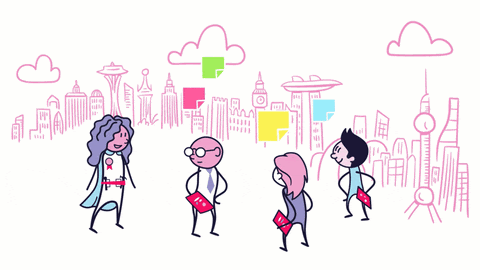Earlier this year, I ran my first workshop with my product team at HubSpot. The goal was to uncover themes and questions they had — and there were quite a few — around improving users’ experience navigating and finding correct tools. The project was a big one that affected navigation, the interaction flows across tools, and how users interact with the tool.
So, did I succeed in what I set out to do? Sure.
Was it the smoothest experience? Not really.
I’ve split this post into two sections to share my experiences running a workshop, and the lessons I’ve learned that might help you do the same.
My experience running the workshop
Think of a workshop as an opportunity to hear your team in a non-structured meeting space. It aids in uncovering themes and questions you might not have thought of, finding interesting trends, or maybe generating data points about the workshop attendees.
For me, this workshop worked on the former: uncovering themes and questions.
I was super excited when I first got buy-in to do it, but as the day grew closer, a sense of being woefully underprepared grew.
This was the first time I had ever run a workshop. I’ve done focus groups, academic seminars, and other group-type activities, but workshops didn’t map onto those activities the same way. Partially due to focus, but mostly because I wanted to facilitate divergent thinking — a fancy word for brainstorming — to find common threads across questions.
I found my teammates asking “what is the workshop about?” or “what are we going to do in the workshop?” — not in a mean way, but out of genuine curiosity. It was great knowing everyone was on board and wanted it to be successful, but those questions only increased my nervousness.
I knew what I wanted to achieve, but how to get there? That took some thinking.

I have to thank my colleagues on the HubSpot UX team for sharing their ideas for exercises and activities, so I could go from 0 to 100. Or try to, at least. The result was a workshop that involved sticky notes, sharing, some discussion, and a whiteboarding/categorization exercise.
Awkward silences and one slide hiccup aside, I did achieve what I set out to do. It wasn’t the most fun or engaging workshop, but we discovered many unspoken questions that the team had. The best part was that both veterans and newer folks on the team had questions that were focused on similar themes, which told me that we really needed to dig in and answer them.
More importantly, the questions we raised turned out to be similar across team members in different roles. While the framing and wording of our questions might differ, it highlights the importance of involving different stakeholders and communicating with them. Even if engineering comes at or after the end of the UX design process, they likely also have the same high-level questions about your users, who they are, and how they use the product.
I’ll be honest: My first workshop wasn’t perfect. There were small bumps and odd silences that detracted from the experience, and that unnerved me a bit. But I didn’t let them derail me from my goals.
Despite the hiccups and kinks, it was a valuable experience. Not only was running a workshop a great way for my team to get involved in the research process, it also allowed various team members to hear the questions and gaps in knowledge their peers had. I don’t know when I might run another, but the thought of it is certainly on my mind. I feel like I’ve learned a lot from the experience, and I know I’ll only get better with practice.
Tips for your own workshop
So what makes a workshop successful? Is it the findings? The team aligning on some common theme? Or something else? I’ll leave that up to you. But here are a few things I’ve learned that’ll help make any workshop successful.

- Make it fun. Try adding whiteboards, sticky notes, or some kind of interaction outside of discussions and conversation. Food, music, and the occasional joke can also go a long way. In longer venues, short breaks and stretching is a nice way to break up sitting for a long time.
- Build rapport. Whether it’s a warm-up or some other activity, this is essential. Just because you’re familiar with everyone in the room doesn’t mean everyone else is. Breaking the ice can make sharing awkward things less awkward. A little discomfort is natural, but you don’t want people to be scared of speaking, either.
- Have a plan. And then plan for some awkward silences, questions, and things going off the books. Activities can end early, but try not to make them drag on. Practicing the plan or sharing what you’re planning, and getting feedback from peers will help turn ‘meh’ into amazing.
- Moderate it. Make sure someone doesn’t take over the conversation. We’re pretty good with this at HubSpot, but sometimes there’ll be someone who takes over. As a moderator, it’s important to step in when necessary so everyone has a voice.
- Be prepared. Make sure you always have some writing utensil or something to take photos/recordings. You never know when someone will have to jot things down, sketch something, or say something meaningful. Think of a workshop as a way to share ideas. And documenting it only makes it that much more successful.
- Seek feedback. This is the only way to get better.. It’s also one of the great things about running your own internal workshop. Making a Google Form or short survey asking your peers to give anonymous feedback can be helpful in targeting areas to improve.
- Share findings. Make sure you communicate out what was found. Particularly with those who attended. On one hand, they’ll know their input was valued and be that much more interested in sharing next time. And on the other, it’ll also increase your credibility and help gain you buy-in from your team.
I encourage you to try running your own workshop. It's a great way to inform the next couple of stages of research, design, or product, and align your team. Treat it as one step in the process and not just a one-off or endpoint. The findings you glean will provide new avenues for exploration. Maybe you’ll converge on some common threads or maybe you’ll find more things to chase down. As your products evolve, so will your users, and the questions you might have surrounding them.
